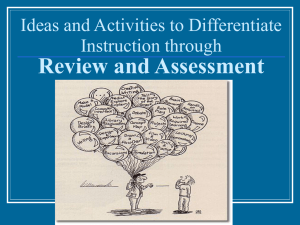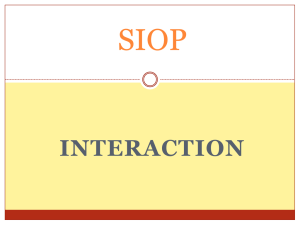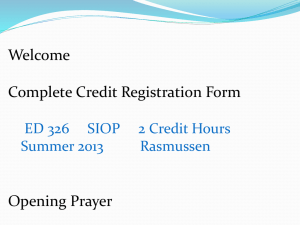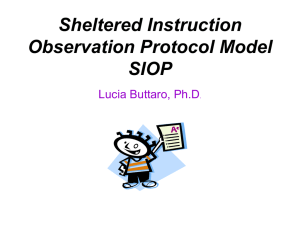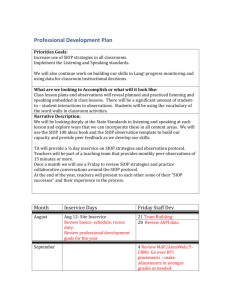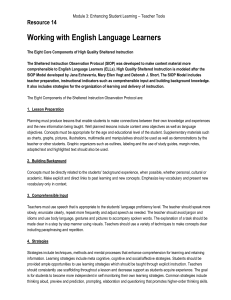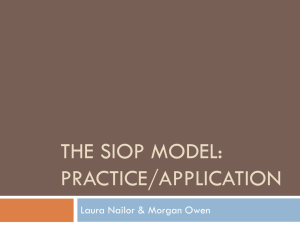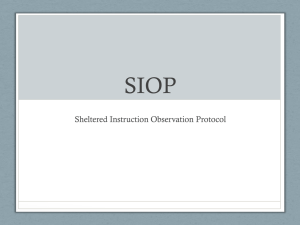SIOP Summary - Moroni-ITEP
advertisement
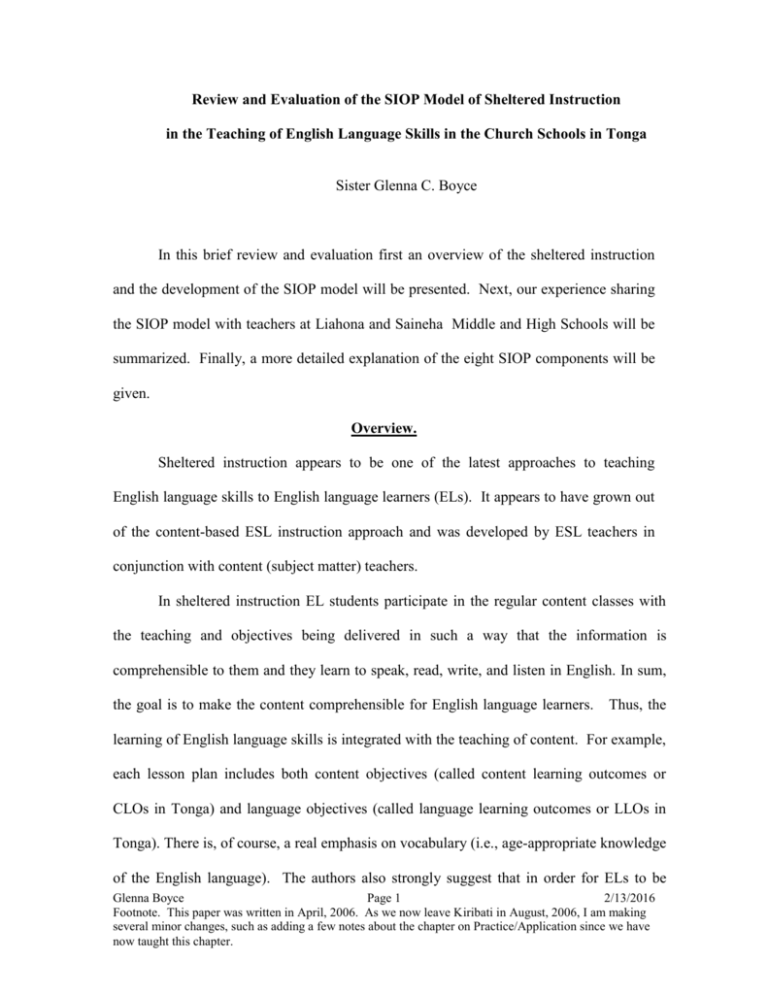
Review and Evaluation of the SIOP Model of Sheltered Instruction in the Teaching of English Language Skills in the Church Schools in Tonga Sister Glenna C. Boyce In this brief review and evaluation first an overview of the sheltered instruction and the development of the SIOP model will be presented. Next, our experience sharing the SIOP model with teachers at Liahona and Saineha Middle and High Schools will be summarized. Finally, a more detailed explanation of the eight SIOP components will be given. Overview. Sheltered instruction appears to be one of the latest approaches to teaching English language skills to English language learners (ELs). It appears to have grown out of the content-based ESL instruction approach and was developed by ESL teachers in conjunction with content (subject matter) teachers. In sheltered instruction EL students participate in the regular content classes with the teaching and objectives being delivered in such a way that the information is comprehensible to them and they learn to speak, read, write, and listen in English. In sum, the goal is to make the content comprehensible for English language learners. Thus, the learning of English language skills is integrated with the teaching of content. For example, each lesson plan includes both content objectives (called content learning outcomes or CLOs in Tonga) and language objectives (called language learning outcomes or LLOs in Tonga). There is, of course, a real emphasis on vocabulary (i.e., age-appropriate knowledge of the English language). The authors also strongly suggest that in order for ELs to be Glenna Boyce Page 1 2/13/2016 Footnote. This paper was written in April, 2006. As we now leave Kiribati in August, 2006, I am making several minor changes, such as adding a few notes about the chapter on Practice/Application since we have now taught this chapter. successful they must also understand the “academic” language of the classroom. Learning how to do academic tasks was a new idea for us; we had not thought of explicitly teaching, demonstrating, and modeling them. Examples include generating the format of an outline, negotiating roles in cooperative learning groups, interpreting charts and maps, etc. Students must understand the teacher’s instructions in order to complete tasks correctly. An English teacher at Liahona gave an example of the misunderstanding of simple directions. She had asked the students to explain a paragraph after reading it. She noticed that one boy wrote, “I liked this paragraph because…..He didn’t understand the meaning of “explain”. Thus, teaching classroom, academic, or functional language(as it is sometimes called in the text) is also emphasized. Table 1. Sheltered Instruction Model ESL Standards Listening in English Speaking in English Reading in English Writing in English How to Teach what Students Need (SIOP) Preparation Building Background Comprehensible Input Strategies Interaction Practice/Application Lesson Delivery Review/Assessment Content Area Standards Grade level Standards Country Standards External Exams Adapted from Echevarria, Vogt, & Short (2004) The SIOP model of sheltered instruction was developed as a 7 year research project funded by the U.S. Department of Education. It was developed cooperatively by the researchers and middle school teachers in four large metropolitan school districts in the U.S. We think it was very important for them to involve actual teachers in a Glenna Boyce Page 2 2/13/2016 Footnote. This paper was written in April, 2006. As we now leave Kiribati in August, 2006, I am making several minor changes, such as adding a few notes about the chapter on Practice/Application since we have now taught this chapter. participatory way. The team reviewed the literature for best practices in ESL and content teaching and incorporated them into the SIOP model. As the authors state, “The SIOP model shares many features recommended for high quality instruction for all students, but adds key features for the academic success of students learning through a second language.” (Echevarria, Vogt, & Short, 2004, p. 215). A protocol for evaluation of teaching (to see to what extent the teacher is using the SIOP principles and strategies) was developed. It can be used by the teacher to assess his/her own teaching or by others who observe the teacher teaching. The protocol is composed of 30 items grouped within the eight components that the SIOP model has determined to be essential to effectively teach content and language skills to English learners. These eight components include, (1) Preparation, (2) Building Background, (3) Comprehensible Input, (4) Strategies, (5) Interaction, (6) Practice/Application, (7) Lesson Delivery, and (l8) Review/Assessment. (Refer back to Table 1 and see the graphic organizers for each component later in the paper). The SIOP model has been tested by comparing the results of students’ writing in classes taught by teachers who were highly trained in SIOP (experimental group) with students’ writing in classes taught by teachers who were not trained in SIOP (control group). The comparative research design included pre- and post-testing. Analysis of covariance was used with pretest writing scores being used as the covariate. Results demonstrated that English learners in sheltered classes with teachers trained in SIOP improved their writing and outscored the students in control classes in the post-test. The differences were statistically significant. Thus, the SIOP model has been demonstrated to be effective. Glenna Boyce Page 3 2/13/2016 Footnote. This paper was written in April, 2006. As we now leave Kiribati in August, 2006, I am making several minor changes, such as adding a few notes about the chapter on Practice/Application since we have now taught this chapter. The components we have taught thus far include practices that appear to be basic to good teaching, as well as providing the teaching and experiences students learning English need in order to learn content and language skills. For example, the ideas presented in Lesson Preparation would help any teacher----to learn new ideas or to reinforce practices they already are doing. One of the ideas, that of learning when and how to adapt content, appears to be very important for teaching ELs. Other examples follow. We found the ideas presented in Building Background excellent and essential because we firmly believe new concepts have to tie to previous understanding and experience. For example, unless we tie the Tongan names to something we know we cannot remember them! The specific examples given in the Comprehensible Input chapter seemed to really remind teachers of what they should be saying and doing. Scaffolding is explained in the Strategies and Building Background chapters. I knew about scaffolding from my child development study and felt that it made great sense in supporting children’s learning appropriately. I had not heard about it in terms of teaching in the classroom. If teachers can adopt this philosophical view that the student is the active learner and their job is to support student efforts to learn until students can become independent in a specific area, it will greatly benefit their teaching. The information about using structured groups to learn and teach others, doing specific tasks will help reduce student embarrassment in speaking English in front of others. There is less threat in speaking to one or two others than in talking to a whole class. Other effective ideas are discussed in the third part of the paper. They will reinforce good teaching and provide many ideas/suggestions to try. Glenna Boyce Page 4 2/13/2016 Footnote. This paper was written in April, 2006. As we now leave Kiribati in August, 2006, I am making several minor changes, such as adding a few notes about the chapter on Practice/Application since we have now taught this chapter. Our Experience. In this section we summarize our experience in teaching the SIOP model at Liahona and Saineha. In our classes with the teachers at Liahona and Saineha we have attempted to teach the SIOP method, after having been introduced to it by teachers at BYU Provo and Hawaii. We covered the first five components. The Liahona High School and Middle Schools each adopted plans whereby teachers who had taken the SIOP course are continuing to provide inservice instruction on the SIOP method. They are using the text and video to do so. At Saineha we presently are on the third component and hope to finish at least 5 components. The follow-up plan is yet to be developed. We find the SIOP model with the text and accompanying video that shows teachers demonstrating in actual classrooms each of the eight components to be a workable approach to teaching English language skills. We feel strongly that all teachers must teach English language skills because each content area has its own academic language. We developed a work book of class activity ideas for teachers to use. Most of the ideas came from a book that has been written to support the use of the SIOP components. It is entitled, “Teaching Ideas for Implementing the SIOP Model” by Vogt & Echevarria. The text is academic reading; therefore, we have to adapt it. (We also struggled to learn the “vocabulary of ESL teaching”.) There are many vocabulary words the teachers don’t know. But the real life examples in the video and the scenarios in each chapter give the teachers many practical ideas. By comparing three teachers in the scenarios who are teaching the same content, it is easy to understand why some practices Glenna Boyce Page 5 2/13/2016 Footnote. This paper was written in April, 2006. As we now leave Kiribati in August, 2006, I am making several minor changes, such as adding a few notes about the chapter on Practice/Application since we have now taught this chapter. work better than others. We realize there are other texts with excellent ESL teaching strategies and that there is a great deal of overlap between ideas presented in the various texts. As the SIOP authors stated, they did an extensive review of teaching practices and included those they deemed “best practice.” For us as beginners in this field, it gave us a way to begin and the videos and scenarios gave practical examples. The schools here have adopted the idea that all teachers will teach English language skills and language objectives have been added to the content objectives in the lesson plans. We hope that this English language learning initiative is carried on. Otherwise, it will not have much effect, even though the teachers and administrators have greeted it enthusiastically. We support the idea advanced by Brett Macdonald of having teachers in the different content areas prepare and teach the SIOP model in relation to the content they teach to other teachers in the South Pacific church schools who teach the same content. We feel that the training would be more effective if the training (preservice and in-service) was conducted by faculty of the various South Pacific schools or across the South Pacific schools. If the missionaries are in charge there will be stops and gaps and we will not have the needed continuity. Finally, we have learned that it is a very difficult task to teach a second language, particularly the academic language needed to be successful in English speaking schools. Students need many, many opportunities to speak and write their own thoughts, summaries, comparisons of content concepts, etc. Teachers need to model speaking English at all times at school; they need to encourage students continually; and they need to provide many opportunities for students to speak in which they won’t be embarrassed and will be willing to try speaking English. Glenna Boyce Page 6 2/13/2016 Footnote. This paper was written in April, 2006. As we now leave Kiribati in August, 2006, I am making several minor changes, such as adding a few notes about the chapter on Practice/Application since we have now taught this chapter. Components of the SIOP Model. In this section, the individual components are outlined. Refer back to Table 1 for a listing of the eight components. In the following we have tried to use graphic organizers to explain each component, as we understand them. Lesson Preparation. Lesson preparation includes six practices/topics, including writing content and language objectives; identifying the key content concepts for the day; using supplementary materials to support and contextualize learning; adapting content for English learners when needed; and using only activities that are meaningful. Figure 1. Content & Language Objectives Content Concepts Lesson Preparation Supplementary Materials Meaningful Activities Adaptation of Content Content and learning objectives are defined and discussed. Teachers are to daily write clear and concise objectives. These are to be posted on the board each day Glenna Boyce Page 7 2/13/2016 Footnote. This paper was written in April, 2006. As we now leave Kiribati in August, 2006, I am making several minor changes, such as adding a few notes about the chapter on Practice/Application since we have now taught this chapter. and used to start and end the class. Students read and write the objectives. The point is that there should be no secret about what is being taught that day. Teachers are to carefully examine which and how key content concepts will be presented, making sure that that the content is not diminished, while considering the students’ literacy level, their second language proficiency, their reading ability, etc. Supplementary materials that will provide real-life context and enable students to link prior experience and learning with the new concepts are encouraged. A number of these, including realia (real objects), pictures, visuals (models, charts, time lines, etc.), multimedia, demonstrations, etc., are discussed. Adaptation of content is encouraged to help the students understand what they read. Methods such as graphic organizers, leveled study guides (different levels for different levels of language facility), taped text, jig saw reading and marginal notes are discussed. Finally, teachers are to double check that the activities they plan will be meaningful in terms of students learning the content and not just time-fillers. In teaching this chapter we tried many of the ideas in class and students were given assignments to try others in their classes. It has been a challenge to “model” the principles and strategies presented in the text, but we feel it is essential to do so. Building Background. The chapter on Building Background emphasizes three ways to build background, including linking new concepts to students’ background and life experiences, linking new concepts to prior class learning, and developing key vocabulary. Glenna Boyce Page 8 2/13/2016 Footnote. This paper was written in April, 2006. As we now leave Kiribati in August, 2006, I am making several minor changes, such as adding a few notes about the chapter on Practice/Application since we have now taught this chapter. Figure 2. Building Background Linking New Concepts to Students’ Background Linking New Concepts to Prior Learning Emphasizing Key Vocabulary The information in the background section in this chapter (pp 44-48) clearly points out that new learning must be associated with prior learning and experience in order to be meaningful and remembered. Teachers in Tonga have an especially difficult time understanding examples, stories, and contexts presented in the texts because the texts are primarily written in Australia, New Zealand, and the U.S. and the teachers here haven’t had the same experiences. Thus, they are building background for themselves as well as for their students. The section on emphasizing key vocabulary is excellent and provides many examples of ways to teach and have your students experience vocabulary. It emphasizes that students need to be actively and personally involved in word learning, that they need to be immersed in a rich language environment, and need multiple and varied experiences with words in order to learn them. Glenna Boyce Page 9 2/13/2016 Footnote. This paper was written in April, 2006. As we now leave Kiribati in August, 2006, I am making several minor changes, such as adding a few notes about the chapter on Practice/Application since we have now taught this chapter. Comprehensible Input. Making sure that the explanations, assignments, and instructions of the teacher are understandable to the students is the focus of this chapter. The chapter focuses on the teacher’s use of appropriate speech, including the rate, enunciation, and complexity of speech, explanation of academic tasks, and use of techniques to make the material understandable (comprehensible). Teachers are also strongly encouraged to be positive, supportive, and enthusiastic. Figure 3. Comprehensible Input Appropriate Speech for ELs Use of Teaching Techniques Explanation of Academic Tasks In the explanation of academic tasks sections, teachers are encouraged to make sure their instructions are step by step and to write the instructions on the board, on papers for each group for group work, etc. to ensure students understand what they are to do. Techniques that have been introduced before in the text are again suggested to support the students’ understanding of the teacher’s verbal communications. These include adapting content, scaffolding, and providing students opportunities to use strategies to understand the information. Glenna Boyce Page 10 2/13/2016 Footnote. This paper was written in April, 2006. As we now leave Kiribati in August, 2006, I am making several minor changes, such as adding a few notes about the chapter on Practice/Application since we have now taught this chapter. Strategies. The background information in this chapter discusses cognitive and metacognitive strategies, as well as the influence social and affective variables have on cognition. We found these concepts difficult to teach, so instead we talked mostly about thinking strategies, both the strategies teachers could use to encourage thinking and the thinking strategies that the students themselves needed to develop. We focused on three sections of the chapter: learning strategies, scaffolding techniques, and questioning techniques. Figure 4. Strategies Scaffolding Techniques Learning Strategies Questioning Techniques TESOL Standards and goals emphasize that the students will use “learning strategies” to extend their communicative competence, to construct and apply their academic knowledge, and to extend their sociolinguistic and sociocultural competence. The chapter introduces a number of strategies for learning, including mnemonics, SQP2RS, GIST, rehearsal strategies (such as flash cards), graphic organizers, etc. It emphasizes that students need to know the strategy, know how to use it, and know when to use it. Teachers need to explicitly teach learning strategies and model them. Glenna Boyce Page 11 2/13/2016 Footnote. This paper was written in April, 2006. As we now leave Kiribati in August, 2006, I am making several minor changes, such as adding a few notes about the chapter on Practice/Application since we have now taught this chapter. Scaffolding is the second strategy discussed. Scaffolding is part of Vygotsky’s (1978) notion of the Zone of Proximal Development (ZPD). This zone includes the skills the child (Vygotsky’s work was with young children.) is ready to learn, but can’t do yet. Thus, a parent or teacher can support the student’s learning as the student begins, but reduces his/her support as the student becomes more proficient. Helping a child learn to ride a bike is a prime example. The parent holds onto the bike and helps guide, while the child is learning to pedal and balance. As the child learns the parent gradually reduces his support until the child can ride alone. The chapter explains ways the teacher can provide verbal scaffolds and procedural scaffolds to help students increase their independence in learning a concept or skill. Finally, the chapter talks about how to ask appropriate questions and encourages teachers to ask questions that will promote higher levels of thinking. Bloom’s taxonomy of six levels of educational objectives is mentioned. A simplified hierarchy (literal, interpretive, and applied) of comprehension is also discussed. Interaction. This chapter discusses the opportunities for meaningful interaction in the classroom between the teacher and students and among the students in structured groupings that allow students to practice using academic language. It states that in most classrooms teachers dominate the opportunities to use academic language and that often students have little opportunity to speak and use the academic language. Teachers are encouraged to balance teacher-to-student talk with opportunities for students to talk about the content. Glenna Boyce Page 12 2/13/2016 Footnote. This paper was written in April, 2006. As we now leave Kiribati in August, 2006, I am making several minor changes, such as adding a few notes about the chapter on Practice/Application since we have now taught this chapter. Secondly, grouping configurations are discussed. Teachers are encouraged to provide structured grouping opportunities (pairs, groups of 3 or 4, and large groups) for students to interact and talk about the content in meaningful ways. Using a variety of grouping configurations during the lesson is a primary component of the SIOP method. Thirdly, wait time (the length of time between utterances during an interaction) is discussed. Typically, teachers do not allow enough wait time for students to think and formulate their replies (particularly when they are doing this in a second language). Finally, the text advocates clarifying key concepts in the students’ native language (L1). We have not emphasized this, for fear of people thinking we weren’t abiding by the “English Only Please”. However, the auto mechanics teacher here was teaching a class about the parts of a car (such as windshield, horn, windshield wipers (or the British term for this). I’m certain the students would know these parts by the Tongan names and I think the vocabulary could be taught more easily if the Tongan counterpart words could be introduced to teach the English words. Figure 5. Interaction Classroom Opportunities for Interaction Grouping Configurations Wait Time Clarify Concepts in L1 Glenna Boyce Page 13 2/13/2016 Footnote. This paper was written in April, 2006. As we now leave Kiribati in August, 2006, I am making several minor changes, such as adding a few notes about the chapter on Practice/Application since we have now taught this chapter. Practice/Application. We did not have time to teach this chapter in Tonga, but we did here in Kiribati. The chapter discusses some key teaching strategies, such as providing ELs with a variety of hands-on experiences, guided practice, and applying opportunities for students to apply new knowledge in a variety of ways. Within the discussion of guided practice we examined the concepts of ‘massed’ and ‘distributed’ practice. One of the analogies given in the chapter is that new knowledge is like wet cement. It is fragile until it hardens. Thus, practice and application of new knowledge is essential if that knowledge is to be incorporated into the student’s learning. The content of the chapter is diagrammed below. . Figure 6. New language and content knowledge presented Hands-on practice with new knowledge Integration of Language Skills Content Application of knowledge in new ways Language Lesson Delivery. The introduction (background) section of this chapter says that, “This chapter addresses the way a lesson is delivered, how well the content and language Glenna Boyce Page 14 2/13/2016 Footnote. This paper was written in April, 2006. As we now leave Kiribati in August, 2006, I am making several minor changes, such as adding a few notes about the chapter on Practice/Application since we have now taught this chapter. objectives are supported during the lesson, to what extent students are engaged in the lesson, and how appropriate the pace of the lesson is to students’ ability levels” (p. 131). The graphic organizer for Lesson Delivery follows. Figure 7. Planning Lessons Enacting Lessons Content Support Objectives During Lessons Promote Student Engagement Language Pace Lesson Appropriately We have not taught these concepts per se, but the elements have been taught throughout the course as part of our demonstrations and their lesson plans and assignments. We have not, however, talked about pacing. Review/Assessment. As we start to read and understand these SIOP components we are struck with the importance of reviewing lesson objectives, vocabulary, and key content concepts. Likewise, we deem it very important to regularly provide students’ feedback on how they are doing and continually assess their comprehension, usually informally, during the class. I also would group within this component the importance of selfGlenna Boyce Page 15 2/13/2016 Footnote. This paper was written in April, 2006. As we now leave Kiribati in August, 2006, I am making several minor changes, such as adding a few notes about the chapter on Practice/Application since we have now taught this chapter. assessment----how did the lesson go; what went well and what didn’t; and what should I do differently next time. The graphic organizer follows: Figure 8. Review Lesson Objectives Key Vocabulary Key Content Concepts Assess Lesson Objectives Regular Feedback on Student Output Assess Student Comprehension Final notes. We are sure that the SIOP model is not the “be all” or “end all”. We’re sure there are other excellent programs. However, it has given us a framework to teach from and a sufficient variety of helps to be somewhat successful. Again, carrying on the teaching, reminding, reinforcing of SIOP principles and components is essential or the teaching we have done will soon be forgotten. In each school we have helped the administration develop a plan to continue teaching the SIOP principles/components in faculty meetings, in-service, and/or departmental meetings. Each plan is different, as it should be, to work in the individual schools. We hope these plans are successful. The ITEP missionaries are supporting and working with the administrations at the schools to continue the teaching. In Kiribati the ITEP missionaries are working on integrating the CES Initiative principles with the SIOP principles. We think that this integration is extremely important. Glenna Boyce Page 16 2/13/2016 Footnote. This paper was written in April, 2006. As we now leave Kiribati in August, 2006, I am making several minor changes, such as adding a few notes about the chapter on Practice/Application since we have now taught this chapter.
